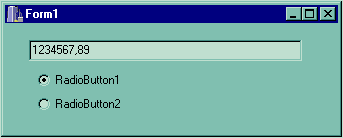|
/*Edit_Digit_Virg
O exemplo a seguir
leva um Edit (que, via teclado, aceita apenas valores numéricos e backspace) e dois RadioButtons
no Form. Quando o usuário dá um clique no RadioButton1, o programa
providencia a colocação de uma vírgula a duas casas decimais do final da
string numérica. O evento OnKeyPress
do Edit possui um código para providenciar o acerto constante da vírgula a
duas casas decimais, sempre que houver a inserção ou exclusão de dados.
nota: esse código é apenas
exemplificativo, carecendo de alguns acertos para um uso mais profissional.*/

//---------------------------------------------------------------------------
#include
<vcl.h>
#pragma hdrstop
#include "Unit1.h"
//---------------------------------------------------------------------------
#pragma package(smart_init)
#pragma resource "*.dfm"
TForm1 *Form1;
//---------------------------------------------------------------------------
// vetor para
receber a string
char
buffer[100];
/*variável
para trabalhar na alteração da posição da vírgula*/
char buf;
/*booleana para
desabilitar a inclusão de uma segunda vírgula*/
bool virgula = true;
//---------------------------------------------------------------------------
__fastcall
TForm1::TForm1(TComponent* Owner)
: TForm(Owner)
{
}
//---------------------------------------------------------------------------
void __fastcall
TForm1::RadioButton1Click(TObject *Sender)
{
if(virgula == true
&& Edit1->Text != "")
{
char buffer[100];
strcpy
(buffer, Edit1->Text.c_str()); // converte Text de AnsiString para char*
buffer[(Edit1->Text.Length()) + 1] = buffer[(Edit1->Text.Length())];
buffer[(Edit1->Text.Length())] =
buffer[(Edit1->Text.Length())- 1];
buffer[(Edit1->Text.Length()) - 1] = buffer[(Edit1->Text.Length())- 2];
/**************************************************************
Para colocar a vírgula a quatro casas decimais do final,
acrescente as linhas de código que estão na forma de comentários
e substitua os valores na forma de comentários no final de
algumas das linhas de código abaixo: os valores -4,
-5 ou -6.
***************************************************************/
//
buffer[((int)Edit1->Text.Length())
- 2] = buffer[((int)Edit1->Text.Length())-
3];
// buffer[((int)Edit1->Text.Length()) - 3] = buffer[((int)Edit1->Text.Length())- 4];
buffer[(Edit1->Text.Length())
- 2] = ','; // - 4
Edit1->Text = buffer;
virgula
= false;
}
else
return;
}
//---------------------------------------------------------------------------
void __fastcall
TForm1::Edit1MouseUp(TObject *Sender, TMouseButton Button,
TShiftState Shift, int X, int Y)
{
// coloca o cursor no final do
Edit
Edit1->SelStart
= (Edit1->Text.Length());
}
//---------------------------------------------------------------------------
void __fastcall
TForm1::Edit1KeyPress(TObject *Sender, char
&Key)
{
/*** O
código abaixo faz que o edit
aceite apenas valores numéricos através do teclado */
// (backspace == 8)
if(Key != 8)
{
// (valor 1 == 48) .. (valor 9 == 57)
if((Key < 48) || (Key > 57))
{
Key = 0;
}
}
/*O código abaixo
mantém a vírgula a duas casas
decimais (...,00) do final da string *********/
if(RadioButton1->Checked
== true)
{
if (Key != VK_BACK) // Key !=
backspace
{
saida:
// converte Text de AnsiString para char*
strcpy (buffer, Edit1->Text.c_str());
buf = buffer[(Edit1->Text.Length())
- 2]; //-4
buffer[(Edit1->Text.Length()) - 3] = buf; //-5
buffer[(Edit1->Text.Length()) - 2] = ','; //-4
Edit1->Text =
buffer;
// coloca o cursor no final do Edit
Edit1->SelStart = (Edit1->Text.Length());
}
if (Key == VK_BACK)
{
// converte Text de AnsiString para char*
strcpy (buffer, Edit1->Text.c_str());
buf = buffer[(Edit1->Text.Length())
- 4]; // -6
buffer[(Edit1->Text.Length()) - 3] = buf; // -5
buffer[(Edit1->Text.Length()) - 4] = ','; // -6
Edit1->Text =
buffer;
// coloca o cursor no final do Edit
Edit1->SelStart = (Edit1->Text.Length());
}
}
}
//---------------------------------------------------------------------------
|
